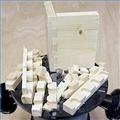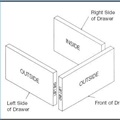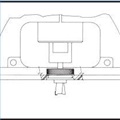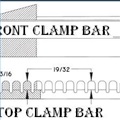How to Use a Dovetail Jig Router
There are many types of dovetail jigs available to choose from, with various options to make the project of your choice. Most dovetail jigs are used to make the joints for drawers. The dovetail joint is like a finger-locking joint that holds firmly, making the drawer a solid piece. The major differences in the types of jigs are the material, the different attachments and the amount of clamps and adjustments. No matter which one you decide on, the overall basic steps for using them are about the same.
Instructions
Things You'll Need:
-
1Wood pieces for drawer
-
2Scale or ruler
-
3.Make sure the dovetail jig is fully assembled with no loose parts. Select the correct template for the type of joint you want to cut. In this example, we will say it is a 1/2-inch blind dovetail joint.
-
5.
Select some scrap pieces of wood to test the first dovetail joint to be cut. This will allow you to make any adjustments before cutting the finish pieces for the drawer. -
6.
Plane all boards so they are perfectly flat, not cupped, and the ends are at a perfect 90-degree angle. This will make the best joint. If the boards are off, there will be gaps in your joints. -
8.
Set up the boards for your drawer and label each one as left, right, front and back, and then label each as the inside or outside piece. -
10.
Set up the router. Insert the template guide in the hole at the router base, followed by the template lock guide, and tighten firmly to lock the template into place. Insert the dovetail bit through the template guide into the router collet and adjust it so the bit protrudes out from the router base 9/16 inch. -
12.
Clamp the drawer pieces in place in the dovetail jig. Place the left-side drawer inside out under the front clamp bar, allowing the piece to extend 1/4 inch above the top surface of the base of the jig. -
14.
Place the drawer front, inside up, under the top clamp bar with it butting up against the left-side drawer piece that was extended out. -
15.
Set the 1/2-inch blind dovetail template on top of the front drawer piece. Use a scale or ruler to adjust locknuts so there is 9/32 inch from the back template slots to the edge of drawer on both ends of the template. Tighten the screw nuts until the template is secured firmly in place. -
16.
Loosen the top clamp bar and adjust the drawer front so that the left edge is 3/16 inch past the left of the first template slot, and clamp in place. -
17.
Remove the template temporarily and find the #1 edge guide against the drawer front. Secure in place and then put the template back in place and secure it firmly. -
18.
Loosen the front clamp bar and raise the side of the drawer so that it is in contact with the underside of the template and against the edge guide. Tighten the front clamp bar securely. -
19.
Plug in the router after making sure the power button is in the off position. Place the router squarely on the finger template to the right of the drawer pieces. -
20.
Make sure the router bit is clear of the jig and wood pieces. Turn on the motor and move along the template from right to left, cutting out the joint pieces. -
21.
Inspect the cuts to make sure they are clean and cut completely. Remove the drawer pieces from the clamps and connect them together. -
22.
If everything is a good fit, complete the cuts on the finish pieces of the drawer. If the joint is too loose, slightly increase the depth of the cut. If the joint is too tight, decrease the depth of the cut. The bit is raised or lowered by adjusting the router motor in the router base with the motor "off." -
23.
If the front overhangs the side of the drawer, decrease the 9/32-inch dimension when clamping the drawer parts. If the side overhangs the front piece, increase the 9/32-inch dimension when clamping the drawer parts.
Tips & Warnings
-
1
Solid wood or high-end plywood is the best to prevent tear-out. Cheap plywood will almost always have a bad tear-out when cutting the dovetail joint. -
2
Make sure the work area is clean from any debris before working on your project. Turn the power off the router before adjusting any pieces on it.






